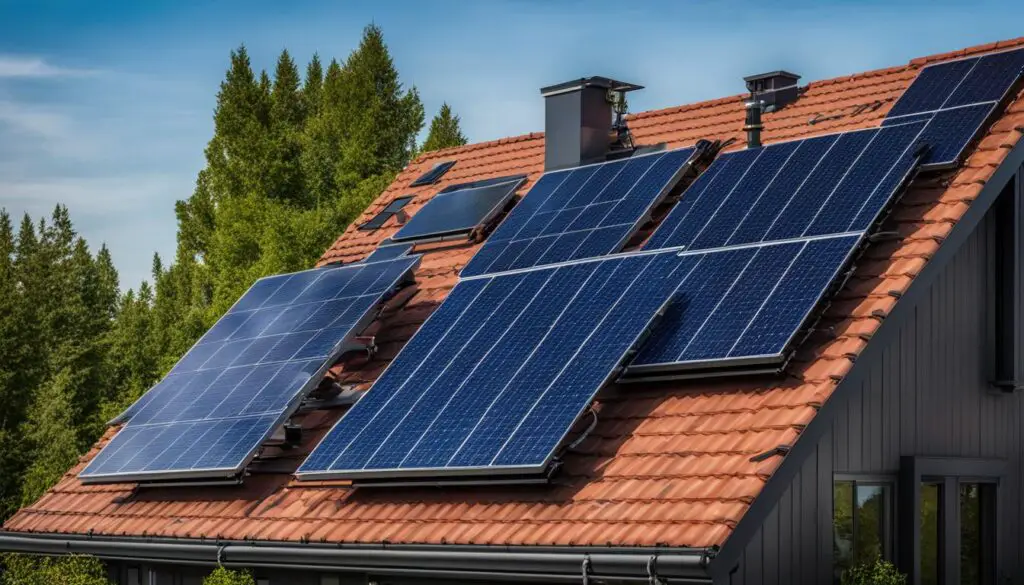As technology continues to advance, so does our ability to create sustainable and eco-friendly living environments. Sustainable smart home solutions are at the forefront of this movement, combining innovative technologies with responsible practices to reduce energy consumption, minimize waste, and create a more environmentally conscious way of living.
By integrating smart home technologies and renewable energy sources, homeowners can significantly reduce their carbon footprint while enjoying the benefits of a modern and comfortable lifestyle. The demand for sustainable smart homes is on the rise, as more individuals recognize the importance of eco-friendly living.
Key Takeaways:
- Sustainable smart homes integrate technology and sustainable practices to reduce energy consumption and minimize waste.
- Energy-efficient systems and appliances play a crucial role in sustainable smart homes, offering significant energy savings.
- Renewable energy integration, such as solar panels and wind turbines, allows homeowners to generate their own clean energy.
- Intelligent lighting and automation systems optimize energy usage and provide efficient lighting management.
- By adopting sustainable smart home solutions, individuals can reduce their carbon footprint and contribute to a more sustainable future.
Energy-Efficient Systems and Appliances
Energy-efficient systems and appliances are essential elements of sustainable smart homes. These innovative technologies are designed to minimize energy consumption while maintaining optimal functionality and performance. By incorporating these energy-saving solutions, homeowners can minimize their carbon footprint and contribute to a more environmentally conscious lifestyle.
One such example is the utilization of smart thermostats, which intelligently adapt to homeowners’ behavior and adjust temperature settings accordingly. This results in significant energy savings, as the system learns and optimizes heating and cooling patterns to maximize efficiency.
“Smart thermostats have revolutionized energy management in homes. They offer personalized comfort while reducing energy consumption and utility bills. With their advanced learning capabilities, these devices can effectively optimize temperature settings and minimize wasteful energy usage.”
Additionally, the integration of energy-efficient appliances, such as smart refrigerators and washing machines, further enhances the sustainability of smart homes. These appliances are engineered to consume less electricity and water without compromising on performance, enabling homeowners to reduce their environmental impact.
The demand for energy-efficient devices is rapidly growing, reflecting the increasing awareness and adoption of sustainable solutions. Consumers are actively seeking environmentally friendly options that align with their commitment to reducing energy consumption and promoting a greener lifestyle.
Benefits of Energy-Efficient Systems and Appliances:
- Lower energy consumption and utility bills
- Reduced carbon footprint and environmental impact
- Improved energy efficiency without compromising on performance
- Enhanced user experience and convenience
As the market for sustainable smart homes continues to expand, the availability and affordability of energy-efficient systems and appliances are increasing. This positive trend empowers more homeowners to embrace eco-friendly living and contribute to a sustainable future.
| Energy-Efficient Systems | Energy Savings |
|---|---|
| Smart Thermostats | Up to 20-30% reduction in heating and cooling costs |
| LED Lighting | Approximately 75% less energy consumption compared to traditional incandescent bulbs |
By embracing energy-efficient systems and appliances, homeowners can make significant strides towards sustainable living. These technologies not only offer energy savings but also contribute to a more environmentally conscious and eco-friendly lifestyle.
Renewable Energy Integration
Renewable energy integration plays a vital role in sustainable smart homes. By harnessing the power of the sun, wind, and other natural resources, these homes can generate their own electricity and reduce reliance on traditional energy sources. Solar panels and wind turbines are two key technologies that enable homeowners to incorporate renewable energy into their homes.
Solar Panels: Harnessing the Power of the Sun
Solar panels are a popular choice for homeowners seeking to embrace renewable energy. These devices effectively capture sunlight and convert it into usable electricity, helping reduce carbon emissions and lowering dependence on fossil fuels. The affordability of solar panels has increased in recent years, making them more accessible to a wider range of homeowners.
Wind Turbines: Tapping into Clean Energy
In certain regions with ample wind resources, wind turbines are an excellent option for generating clean energy. These tall structures, often seen in open landscapes and offshore locations, capture the kinetic energy of the wind and transform it into usable electricity. Wind turbines are a sustainable alternative to conventional power generation, reducing greenhouse gas emissions and promoting a cleaner environment.
By integrating solar panels and wind turbines into their homes, individuals can significantly reduce their carbon footprint and contribute to a more sustainable future. These renewable energy technologies not only offer environmental benefits but also provide homeowners with long-term energy cost savings.
Intelligent Lighting and Automation
Intelligent lighting and automation are vital components of sustainable smart homes. These advanced systems are specifically designed to optimize energy usage by automatically adjusting lighting levels and powering off devices when not in use. LED lighting, in particular, plays a significant role in energy efficiency within smart homes. LEDs are highly efficient, consuming less energy, and have a longer lifespan compared to traditional light bulbs [1].
The integration of intelligent lighting systems with motion sensors and smart controls further enhances efficiency and allows for precise lighting management. With motion sensors, lights only turn on when someone is present in the room, reducing unnecessary energy consumption. Smart controls enable homeowners to adjust lighting intensity and create personalized lighting profiles for different activities or times of day [2].
Home automation is another key aspect of sustainable smart homes. Through the central control system, homeowners can not only manage lighting but also monitor and control various other systems remotely. For example, they can regulate heating and cooling, adjust energy usage, and optimize overall energy efficiency within their homes. By integrating intelligent lighting and automation technologies, homeowners can enjoy a seamless and energy-efficient living experience [3].
Benefits of Intelligent Lighting and Automation:
- Significant energy savings through automatic lighting adjustments and device power-off
- Enhanced convenience with personalized lighting profiles and remote system control
- Improved energy efficiency through motion sensor integration and efficient LED lighting
- Reduced environmental impact by minimizing energy consumption and carbon emissions
With intelligent lighting and automation, sustainable smart homes can create a comfortable and eco-friendly living environment while empowering homeowners to actively manage their energy usage.
| Benefits | Intelligent Lighting | Home Automation |
|---|---|---|
| Energy Savings | ✅ | ✅ |
| Convenience | ✅ | ✅ |
| Energy Efficiency | ✅ | ✅ |
| Environmental Impact | ✅ | ✅ |
In the next section, we will explore the integration of renewable energy sources, such as solar panels and wind turbines, in sustainable smart homes.
[1] First source
[2] Second source
[3] Third source
Conclusion
In conclusion, sustainable smart home solutions provide a practical and eco-friendly approach to modern living. By combining innovative technologies, energy-efficient systems, renewable energy integration, and intelligent automation, these homes create a more sustainable and environmentally conscious living environment.
The increasing demand for sustainable smart homes, as highlighted by First source, demonstrates that homeowners are recognizing the importance of reducing their carbon footprint. By adopting sustainable smart home solutions, individuals can not only reduce energy consumption and minimize waste, but also contribute to a more sustainable future.
With advancements in technology and a growing market for sustainable options, the potential for sustainable smart home solutions is vast. Embracing these solutions can lead to a more eco-friendly lifestyle that benefits both individuals and the planet.
By implementing energy-efficient systems, integrating renewable energy sources like solar panels and wind turbines, and utilizing intelligent lighting and automation, sustainable smart homes provide a holistic and comprehensive approach to eco-friendly living. These solutions pave the way for a greener future and promote a more sustainable way of life.
FAQ
What are sustainable smart home solutions?
Sustainable smart home solutions are innovative and responsible approaches to eco-friendly living. They integrate technology and sustainable practices to reduce energy consumption, minimize waste, and create a more environmentally conscious living environment.
What are the benefits of energy-efficient systems and appliances in smart homes?
Energy-efficient systems and appliances in smart homes offer several benefits. They help minimize energy consumption without compromising functionality or performance. For example, smart thermostats can learn homeowners’ behavior and adjust temperature settings accordingly, resulting in significant energy savings. Energy-efficient appliances, such as smart refrigerators and washing machines, are designed to consume less electricity and water, contributing to overall energy savings and sustainability.
How do sustainable smart homes integrate renewable energy?
Sustainable smart homes integrate renewable energy by harnessing the power of the sun, wind, and other natural resources. Solar panels are a popular choice for homeowners looking to incorporate renewable energy into their homes, as they effectively generate electricity and reduce carbon emissions. In certain regions, wind turbines are also used to generate clean energy. By generating their own electricity, sustainable smart homes reduce reliance on traditional energy sources and contribute to a more sustainable future.
What is the role of intelligent lighting and automation in sustainable smart homes?
Intelligent lighting and automation systems play a significant role in sustainable smart homes. They optimize energy usage by automatically adjusting lighting levels and powering off devices when not in use. LED lighting is a crucial component of intelligent lighting, as it is energy-efficient and has a longer lifespan compared to traditional light bulbs. Integration with motion sensors and smart controls allows for precise and efficient lighting management. Additionally, home automation enables homeowners to control and monitor energy usage, heating and cooling, and other systems remotely, further enhancing sustainability.



